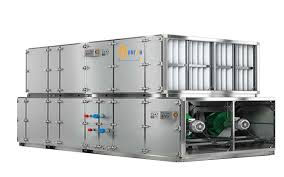How to Choose the Right Heat Exchanger for Your Facility
- cyruscrafts shop
- Jul 12
- 4 min read
In the world of HVAC systems, manufacturing plants, and large-scale facilities, heat exchangers are indispensable. These systems quietly and efficiently manage the transfer of heat between fluids without mixing them—a core task in industrial processes, residential complexes, and even swimming pools. Despite their behind-the-scenes presence, the correct selection of a heat exchanger can significantly impact a system’s overall performance, energy efficiency, and operational cost.
If you're preparing to Purchase Heat Exchanger equipment for a facility or a project, understanding their types, components, and suitability is essential. Whether you’re upgrading your mechanical room or designing a new plant, informed decision-making begins with knowing how these systems work.
The Core Function of Heat Exchangers
As the name suggests, a heat exchanger facilitates the exchange of thermal energy between two media—such as water, steam, oil, or air—without allowing them to come into direct contact. This simple yet powerful mechanism is the backbone of processes ranging from air conditioning and refrigeration to chemical production and water heating.
There are various types of heat exchangers, but two of the most common are shell and tube heat exchangers and plate heat exchangers. Each comes with its own set of benefits and limitations, and the selection largely depends on the application, space constraints, budget, and maintenance preferences.
Shell and Tube Heat Exchangers: Durable and Versatile
These are among the most widely used exchangers, especially in settings where durability and high-pressure tolerance are needed. Structurally, they consist of a cylindrical shell housing multiple tubes through which one fluid flows, while the second fluid moves over the tubes within the shell.
To improve efficiency, many models incorporate baffles—flow-directing plates that increase turbulence and maximize heat transfer. Shell and tube heat exchangers are versatile, able to handle gases and liquids at varying pressures and temperatures, and are often the go-to solution for facilities like oil refineries, HVAC plants, and swimming pool heating systems.
The materials used for the tubes—commonly copper, stainless steel, or titanium—are selected based on thermal conductivity, corrosion resistance, and operating environment. Stainless steel shells are popular due to their pressure tolerance and low heat conductivity.
One variation, the U-shaped tube heat exchanger, is economical to manufacture but more difficult to clean due to its fixed shape. These are typically used in places where internal access is limited and chemical cleaning is acceptable.

Plate Heat Exchangers: Compact and Efficient
Plate heat exchangers are a more recent innovation compared to their shell and tube counterparts but offer excellent thermal performance in compact designs. Made up of multiple thin plates that create flow channels for the fluids, they are widely used in HVAC systems, food processing, pharmaceuticals, and similar industries.
Among plate heat exchangers, the gasketed and brazed or welded models are the most common. Gasketed versions allow for easy disassembly, cleaning, and capacity adjustment, making them ideal for systems that require frequent maintenance or modification.
These heat exchangers shine in situations where space is limited and the pressure and temperature demands are moderate. However, they may not be suitable for highly corrosive or high-pressure applications unless made with specialized materials.

Key Factors to Consider Before You Purchase
Whether you’re replacing an existing unit or installing a new one, there are several critical aspects to evaluate before making a decision:
Application and Fluids Involved: Understand the temperature range, pressure levels, and type of fluids that will pass through the exchanger.
Material Compatibility: Choose materials that resist corrosion and can handle the operating conditions.
Heat Transfer Efficiency: The design and configuration of the exchanger should align with your thermal load requirements.
Maintenance and Cleaning Needs: If regular cleaning is expected, gasketed plate or removable-tube designs are more suitable.
Installation Space and Orientation: Consider the dimensions and weight, especially if you're retrofitting into an existing mechanical room.
A Real-World Perspective: Why Selection Matters
Consider a mid-size educational complex needing both heating and hot water. The engineering team is deciding between compact plate exchangers for the air conditioning system and a more rugged shell and tube unit for pool heating. Because of the high flow rate and operating pressure of the pool system, a shell and tube exchanger with baffles provides the best mix of durability and thermal efficiency.
Meanwhile, in the building’s central HVAC loop, space is a constraint. Here, a gasketed plate exchanger proves ideal, allowing for quick service and a smaller footprint.
This type of dual application—common in commercial and institutional buildings—illustrates why taking the time to select the right exchanger type is not just good practice, but necessary for long-term system reliability.
Expert Insight: Where to Turn for Help
While you can perform preliminary sizing and comparisons based on formulas and specifications, heat exchange systems often require fine-tuning based on real-world factors. Consulting with vendors or independent engineers can help ensure the system you purchase meets your current and future needs.
For example, consulting specialists like those from Damatajhiz, who are experienced in industrial and HVAC-grade thermal systems, can be particularly helpful. Their knowledge of product compatibility, thermal performance, and sizing for unique scenarios can save you time, money, and headaches down the line.
Final Thoughts
Heat exchangers may not be the most visible part of your mechanical infrastructure, but their importance can't be overstated. A well-chosen unit can improve energy efficiency, reduce downtime, and extend the lifespan of your entire system.
Whether you opt for a rugged shell and tube design or a compact plate exchanger, investing time in understanding your specific requirements and reviewing the available options is key to making a sound, cost-effective decision. When it’s time to purchase heat exchanger equipment, let your decision be guided by function—not just form or price.



Comments